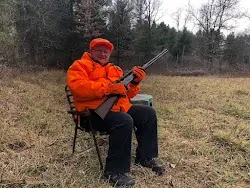Somewhere in my upbringing, the words “don’t brag” have stayed with me. I can hear my dad saying it now, as I write the words. But I do want to mention that this was my 75th year deer hunting, without missing a year. Not when I was in the army. Not when I was in college. Not when I wasn’t feeling well—I was always ready for deer season.
I remember that November day in 1946, when I, for the first time, could join my dad on the annual deer hunt. I carried my dad’s double-barrel 12-gauge shotgun. The barrel was nearly as long as I was tall, and it weighed a ton—or so it seemed for this little 12-year-old.
In those days, there were few deer in Waushara County. If I as much as saw a deer track, it was an exciting moment. Several days during the annual hunt, my dad and our neighbor, Bill Miller, drove a few miles west to Adams County where a few deer could be found in the vicinity of the Roche-A-Cri River. I rode along. My dad was born and raised in that neck-of-the-woods, so he knew the area well. Few people lived there at the time, it was a place for hundreds of acres of woods—and some deer.
Dad dumped me and the 12-guage out on a bridge that crossed the Roche-A-Cri. His words, “Walk along the river to the west and kick out any deer might that be there. Follow the river and you won’t get lost.”
It was a cool, but sunny fall day. As I walked along the river, I spotted something swimming in the water. It was a beaver, and it along with other beavers, were building a dam on the river. I had never seen a beaver before, only pictures. I leaned the shotgun against a big white pine tree and watched the beaver’s work.
When I finally arrived where Pa and Bill Miller were waiting at the ready with their deer rifles, they were certain I had gotten lost. I didn’t tell them I had been watching the beavers and not driving deer.
THE OLD TIMER SAYS: There is much more to deer hunting than trying to bag a deer.
WHERE TO BUY MY BOOKS:
You can buy my books at your local bookstore, order online from bookshop.org, or purchase from the Friends of the Patterson Memorial Library in Wild Rose—a fundraiser for them. Phone: 920-622-3835 for prices and ordering.
Patterson Memorial Library
500 Division Street
Wild Rose, WI 54984
barnard@wildroselibrary.
www.wildroselibrary.org
If you live in the western part of the state, stop at Ruth’s home town, Westby and visit Dregne’s. and look at their great selection of my books. Order a book from them by calling 1-877-634-4414. They will be happy to help you.




